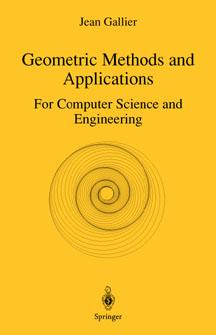

 Review in MathSciNet (item 2)
MathSciNet
Review in MathSciNet (item 2)
MathSciNet
Problem Sets (4 or 5), project, or presentation.

The purpose of this course is to present some of the advanced geometric methods used in geometric modeling, computer graphics, computer vision, robotics, etc.
This semester (Fall 2003), I plan to cover the following topics:
Affine spaces, affine combinations (barycenters), affine subspaces, affine independence, affine frames, convex combinations, affine maps, affine groups, a glimpse at affine geometry (Pappus, Desargues), hyperplanes and affine forms, intersection of affine spaces.
Basic properties of convex sets, Half spaces determined by hyperplanes, Caratheodory's theorem on convex hulls, Radon's theorem, Helly's theorem. Separation theorems: Hahn-Banach theorem and others. Supporting hyperplanes, Minkowski's theorem. Vertices and Extremal points, Krein and Milman's theorem. Convex hulls (algorithms). Polytopes and polyhedra: H-polytopes and V-polytopes. Cones. The main theorem. Fourier-Motzkin elimination, affine case. Fourier-Motzkin elimination for cones. The Farkas lemma. Recession cone and homogenization. Vertices, faces and facets. The face lattice. Polarity and duality. The representation theorem for polytopes. Simplicial and simple polytopes.
Inner Products, Euclidean Spaces, Orthogonality, Orthogonal and Orthonormal bases, A glimpse at Fourier Series, Linear Isometries (also called orthogonal transformations), the orthogonal group, orthogonal matrices, the Groups O(n), SO(n), hyperplane reflections and the Cartan-Dieudonne' theorem, rotations and flips, QR-decomposition, Householder matrices and QR-decomposition.
Bisector hyperplanes, Dirichlet-Voronoi diagrams, Some Basics of combinatorial topology: Simplicial Complexes, Star and Link of a vertex, Singular Points, Triangulations, The Euler-Poincare' characteristic, Delaunay triangulations, and applications. Constrained Delaunay triangulations.
Normal Linear Maps, Self-Adjoint and Other Special Linear Maps, Normal and Other Special Matrices
Polar Form, Singular Value Decomposition (SVD)
Applications to Least Squares Problems, Lagrange Multipliers
The Exponential Map, Some Classical Lie Groups, Symmetric and Other Special Matrices, Exponential of Some Complex Matrices, Hermitian and Other Special Matrices, The Lie Group SE(n) and the Lie Algebra se(n), Finale: Lie Groups and Lie Algebras, Applications of Lie Groups and Lie Algebras
Ge'ome'trie 2, English edition: Geometry 2, Berger, Marcel, Universitext, Springer Verlag, 1990
Metric Affine Geometry, Snapper, Ernst and Troyer Robert J., Dover, 1989, First Edition
A vector space approach to geometry, Hausner, Melvin, Dover, 1998
Geometry, Audin, Michele, Universitext, Springer, 2002
Geometry, A comprehensive course, Pedoe, Dan, Dover, 1988, First Edition
Introduction to Geometry, Coxeter, H.S.M. , Wiley, 1989, Second edition
Geometry And The Immagination, Hilbert, D. and Cohn-Vossen, S., AMS Chelsea, 1932
Methodes Modernes en Geometrie, Fresnel, Jean , Hermann, 1996
Computational Line Geometry, Pottman, H. and Wallner, J., Springer, 2001
Topological Geometry, Porteous, I.R., Cambridge University Press, 1981
Lectures on Polytopes, Gunter Ziegler, Springer (GTM No. 152), 1997
Convex Polytopes, Branko Grunbaum, Springer (GTM No. 221), 2003, Second Edition
Polyhedra, Peter Cromwell, Cambridge University Press, 1999
Convex Sets, Valentine, Frederick, McGraw-Hill, 1964
Convex Analysis, Rockafellar, Tyrrell, Princeton University Press, 1970
Algorithmic Geometry, Boissonnat, Jean-Daniel and Yvinnec, Mariette (Bronniman, H., translator), Cambridge U. Press, 2001
Computational Geometry in C, O'Rourke, Joseph, Cambridge University Press, 1998, Second Edition
Lie Groups. An introduction through linear Linear groups, Wulf Rossmann, Oxford Science Publications, 2002
Linear Algebra and its Applications, Strang, Gilbert, Saunders HBJ, 1988, Third Edition
Applied Numerical Linear Algebra, Demmel, James, SIAM, 1997
Numerical Linear Algebra, L. Trefethen and D. Bau, SIAM, 1997
Matrix Analysis, R. Horn and C. Johnson, Cambridge University Press, 1985
Matrix Computations, G. Golub and C. Van Loan, Johns Hopkins U. Press, 1996, Third Edition
Modern Differential Geometry of Curves and Surfaces, Gray, A., CRC Press, 1997, Second Edition






Topics vary from year to year, and are selected among the following subjects (nonexhaustive list):
Affine spaces, affine combinations (barycenters), affine subspaces, affine independence, affine frames, convex combinations, affine maps, affine groups, a glimpse at affine geometry (Pappus, Desargues), hyperplanes and affine forms, intersection of affine spaces, basic properties of convex sets, half spaces determined by hyperplanes, Caratheodory's theorem on convex hulls, Radon's theorem, Helly's theorem.
Inner Products, Euclidean Spaces, Orthogonality, Orthogonal and Orthonormal bases, A glimpse at Fourier Series, Linear Isometries (also called Orthogonal Transformations), the Orthogonal Group, Orthogonal Matrices, the Groups O(n), SO(n), hyperplane reflections and the Cartan-Dieudonne' theorem, rotations and flips, QR-decomposition, Householder matrices and QR-decomposition, Affine Isometries, the Groups Is(n), SE(n), fixed points, the Cartan-Dieudonne' theorem for rigid motions, flips, Orientations of a Euclidean Space, Angles, Volume Forms, Cross-Products. The Algebra H of Quaternions and the Spaces S^3, SU(2), SO(3), and RP^3, quaternion interpolation
Hermitian Geometry (Sesquilinear Forms, Hermitian Forms, Hermitian Spaces, Pre-Hilbert Spaces, Isometries, Unitary Maps, the Groups U(n), SU(n), Hermitian, reflections, the Cartan-Dieudonne' Theorem, Rotations, flips, Affine isometries, The Groups Is(n, C), SE(n, C), the Cartan-Dieudonne' Theorem, Rotations, flips
A glimpse at Hilbert Spaces
Positive definite matrices, Minimization of a positive definite quadratic form with constraints, Lagrange multipliers, Least Squares Estimation, Equilibrium Equations, Weighted Least Squares, Covariant Matrices, More on convex sets (Kalman filters?).
This includes projective spaces and subspaces, frames, projective maps, multiprojectve maps, the projective completion of an affine space, cross-ratios, duality, and the complexification of a real projective space.
Curvature, torsion, osculating planes, the Frenet frame, osculating circles, osculating spheres.
First fundamental form, normal curvature, second fundamental form, geodesic curvature, Christoffel symbols, principal curvatures, Gaussian curvature, mean curvature, the Gauss map and its derivative dN, the Dupin indicatrix, the Theorema Egregium, equations of Codazzi-Mainardi, Bonnet's theorem, lines of curvatures, geodesic torsion, asymptotic lines, geodesic lines, local Gauss-Bonnet theorem.
Other possible topics include:
Calculus of variations (applied to robotics, vision, computer graphics)
Fourier analysis and
Wavelets and their applications
to image analysis and computer graphics
Optimization methods
Matrix analysis methods, Numerical methods for solving ODE's, PDE's,
Finite elements method.
The table of contents of my book can be found by clicking there:
For more information, visit
Geometric Methods and Applications
For Computer Science and Engineering
I will mix assignments not involving programming, and small programming projects. There are plenty of opportunities for trying out the algorithms presented in the course. In particular, it is fairly easy to program many of these algorithms in Mathematica (I have done so, and I'm not such a great programmer!).
Back to Gallier Homepage
published by:
Jean Gallier